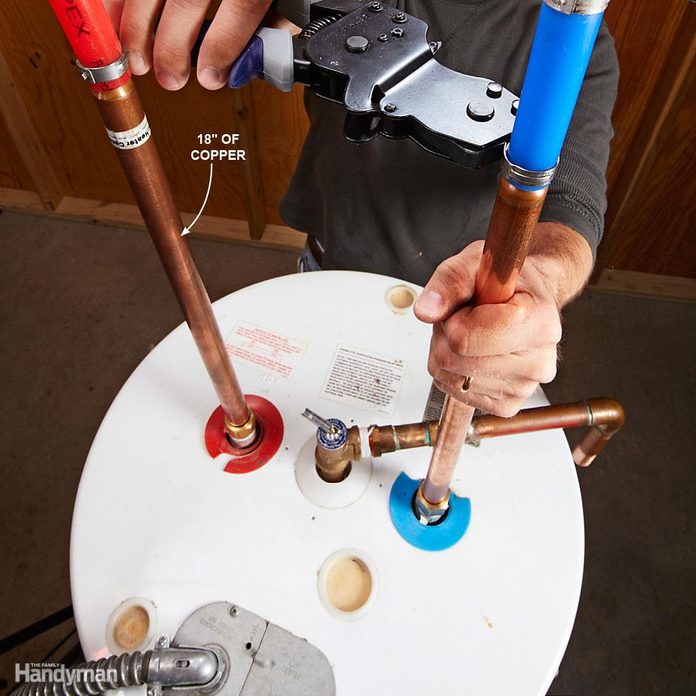Disclosure: This post contains affiliate links and I will be compensated if you make a purchase after clicking through my links. Learn More
Connecting PEX to an electric water heater is a common task. It ensures a reliable hot water supply in your home.
Understanding how to connect these components is crucial for homeowners. It offers a practical way to manage plumbing needs without calling a professional every time. PEX, or cross-linked polyethylene, is a popular choice for modern plumbing. It’s flexible, durable, and easy to work with.
Electric water heaters, on the other hand, provide a consistent hot water supply. Knowing how to connect PEX to an electric water heater can save time and money. It empowers you to handle minor plumbing tasks confidently. This guide will help you understand the basic steps involved. You’ll learn about the tools and materials needed, and safety precautions. Let’s explore how to make this connection effectively.
Preparation
Preparing to connect PEX to an electric water heater can seem daunting, but with the right approach, it becomes manageable. Before diving into the actual connection process, it’s crucial to ensure you have everything you need. Proper preparation not only makes the task easier but also ensures safety and efficiency.
Gather Tools And Materials
Start by gathering all the necessary tools and materials. You’ll need a PEX cutter, crimp rings, a crimp tool, and of course, PEX tubing.
Having the correct fittings is essential. Make sure you have PEX adapters suitable for connecting to your water heater’s inlet and outlet.
Double-check the compatibility of your fittings with your PEX tubing. This small step can save you significant hassle later.
Safety Precautions
Safety should always be your top priority. Before you begin, turn off the power to the water heater. This prevents any electrical mishaps.
Ensure the water supply is turned off as well. You don’t want a flood in your workspace.
Wear protective gloves and safety glasses. These protect you from potential injuries while cutting and crimping the PEX tubing.
Have you ever thought about how much easier a task becomes when you’re well-prepared? Imagine tackling a job only to find out halfway that you’re missing a crucial tool. Frustrating, right?
Taking a few extra minutes to ensure you have everything in place can make the difference between a smooth project and a frustrating one. Have you gathered all your tools and materials? Are your safety measures in place? Now, you’re all set to move on to the next steps with confidence!

Credit: forum.nachi.org
Understanding Pex Tubing
Pex tubing is a popular choice for plumbing in modern homes. It stands for cross-linked polyethylene, a flexible and durable plastic. This material offers many benefits for water systems. Connecting Pex to an electric water heater is a common task. Understanding Pex is essential for a successful connection.
Types Of Pex
There are three main types of Pex tubing: Pex-A, Pex-B, and Pex-C. Pex-A is the most flexible and resistant to kinks. It’s ideal for colder climates due to its expansion capabilities. Pex-B is more rigid but offers great chlorine resistance. Pex-C is less flexible but cost-effective for budget projects. Each type has specific strengths and use cases.
Benefits Of Using Pex
Pex tubing provides several advantages for plumbing systems. It’s flexible and easy to install, reducing labor time. Pex is resistant to scale and chlorine, ensuring water quality. It can expand during freezing, preventing burst pipes. Pex is also quieter than metal pipes, minimizing noise. Its flexibility allows for fewer fittings and connections.
Electric Water Heater Basics
Electric water heaters are essential in many homes. They provide hot water for various needs. Understanding their basics can help in maintenance and troubleshooting. Let’s explore the components and how they work.
Components Overview
An electric water heater has several key parts. The heating elements are crucial. They heat the water inside the tank. Thermostats regulate the temperature. They ensure the water doesn’t get too hot. The tank itself stores the heated water. It’s insulated to retain heat. Cold water enters through the dip tube. Hot water exits via the heat-out pipe. Each part plays a vital role in the heater’s function.
Working Principle
Electric water heaters operate on a simple principle. Cold water enters the tank. The heating elements activate. They warm the water to the set temperature. The thermostat controls the heating process. It turns the elements on and off as needed. Once heated, hot water rises to the top. It’s ready for use when you turn on a hot water tap. The cycle continues to ensure a steady supply of hot water.

Credit: www.familyhandyman.com
Planning The Installation
Connecting PEX to an electric water heater involves careful planning for efficient installation. Ensure all tools and materials are ready. Follow manufacturer guidelines for safe and effective results.
Planning the installation of a PEX connection to an electric water heater is crucial. A well-thought-out plan ensures efficiency and safety. By focusing on critical aspects, you can avoid potential problems. Let’s explore these essential components.
Assessing Space And Placement
Consider the space around your water heater. Is there enough room for connections? Ensure the heater is accessible for maintenance. Measure the area for accurate PEX pipe length. Check for any obstructions. Look for potential hazards, like sharp edges or heat sources. Ventilation is vital to prevent overheating. Keep flammable materials away from the heater. A clear space makes installation easier and safer.
Designing The Water Flow
Plan the water flow path with care. PEX pipes should run directly from the water source to the heater. Minimize bends to maintain strong water pressure. Use appropriate pipe sizes for efficient flow. Consider the hot water demand in your home. Ensure the pipes can handle the expected usage. Proper design prevents leaks and maintains consistent water temperature.
Connecting Pex To Water Heater
Connecting PEX to an electric water heater ensures a secure and efficient setup for your home’s hot water needs. Use the right fittings and tools to ensure a leak-free installation. Always follow safety guidelines and manufacturer’s instructions for optimal results.
Connecting PEX to a water heater involves careful steps. PEX tubing is popular due to its flexibility and ease of installation. Properly connecting it ensures safety and efficiency. Before starting, gather necessary tools and materials. Follow the guidelines to prevent leaks and ensure a smooth flow.
Cutting And Fitting Pex Tubing
Begin by measuring the required length of PEX tubing. Use a sharp cutter to ensure clean cuts. Avoid jagged edges, which can cause leaks. After cutting, fit the tubing with the appropriate connectors. Make sure the fit is snug. This prevents water from escaping and ensures a secure connection.
Securing Connections
Once the tubing is fitted, secure it with clamps. Double-check that the clamps are tight. Loose clamps can lead to leaks. Ensure all connections are tight and secure. Test the connections by turning on the water. Watch for any signs of leaks. Tighten any loose fittings immediately. Secure connections provide reliable water flow.
Testing The System
Testing the system is a crucial step after connecting your Pex to the electric water heater. You want to ensure everything is functioning correctly before you start using the hot water. This process will help you identify any issues early on and address them promptly.
Checking For Leaks
Begin by turning on the water supply to your heater. Inspect all connections closely. Pay special attention to the areas where the Pex meets the heater.
If you see any water droplets forming, tighten the connections. Use a towel to dry the area and check again. A dry connection means no leaks.
Consider using a flashlight to see better. It helps to catch small leaks you might miss otherwise.
Ensuring Proper Water Flow
Next, check the water flow. Turn on the hot water taps in your home. You should get a steady stream of hot water.
If the flow is weak, there may be an obstruction. Check the Pex tubing for bends or kinks. Straighten out any issues you find.
Good water flow ensures that your heater is working efficiently. It also means your connections are secure.
Have you ever tested a water heater system before? Share your experiences in the comments below. Your insights could help others troubleshoot their setups!
Troubleshooting Common Issues
Connecting PEX to an electric water heater involves ensuring tight fittings and avoiding leaks. Regularly check connections for any loose parts or signs of wear. Replace faulty fittings to maintain efficient water flow and prevent damage.
Connecting Pex to your electric water heater can be straightforward, but sometimes things go wrong. Here, we’ll troubleshoot common issues to ensure your installation runs smoothly.
Addressing Leaks
Leaky connections can be frustrating. If you notice water pooling around your heater, check the fittings first. Ensure they are tight but not overly tightened.
Sometimes, a simple adjustment can stop a leak. If tightening doesn’t work, inspect your Pex tubing. Look for cracks or damages that might need replacement.
Use plumber’s tape on threads to create a better seal. This can often fix minor leaks.
Fixing Temperature Fluctuations
Experiencing inconsistent water temperatures? This can be annoying, especially during a shower. Check the thermostat settings on your electric water heater.
Make sure the thermostat is set to your desired temperature. If the temperature still fluctuates, inspect the Pex tubing for blockages. Debris can cause irregular water flow.
Have you considered the age of your water heater? Older units may struggle to maintain consistent temperatures. You might need to replace the heater for better performance.
Do you ever wonder if minor adjustments can solve major problems? They often can, and knowing the right steps makes all the difference.

Credit: www.reddit.com
Maintenance Tips
Maintaining your Pex connections to an electric water heater is crucial. Proper care ensures efficiency and longevity. Regular checks and long-term care can prevent costly repairs. Follow these maintenance tips to keep your system in top shape.
Routine Checks
Check the Pex connections for leaks monthly. Look for signs of wear or damage. Tighten loose fittings to prevent leaks. Inspect the water heater for rust or corrosion. Listen for unusual noises during operation. Ensure the area around the heater is clear of debris. Clean any dust or dirt on the heater’s surface.
Long-term Care
Flush the water heater annually to remove sediment. This improves efficiency and lifespan. Consider insulating Pex pipes to reduce heat loss. Regularly test the temperature and pressure relief valve. Replace it if it shows signs of malfunction. Keep the heater’s manual for reference. Schedule professional inspections every few years. This ensures all components work properly.
Frequently Asked Questions
Can I Connect Pex Directly To An Electric Water Heater?
Yes, you can connect PEX directly to an electric water heater. Use a fitting rated for high temperatures. Ensure compliance with local codes.
Is Sharkbite Ok For A Hot Water Heater?
Yes, SharkBite fittings are suitable for hot water heaters. They can handle high temperatures and provide reliable connections.
Do You Need Special Pex For Hot Water?
Yes, you need PEX tubing rated for hot water. Look for PEX-A or PEX-B, which can handle higher temperatures.
Can Hot Water Melt Pex?
Hot water does not melt PEX. PEX pipes can handle temperatures up to 200°F (93°C) without damage. PEX is designed for hot and cold water applications, making it durable and reliable for plumbing systems. Always ensure installation guidelines are followed for optimal performance.
Final Words
Connecting PEX to an electric water heater is simple and efficient. Follow the steps carefully. Double-check your connections for safety and reliability. Enjoy the benefits of using PEX. It’s durable and flexible. Perfect for plumbing needs. Save time with easy installation.
Reduce maintenance hassles. PEX works well in diverse conditions. It resists corrosion and scaling. Ideal for modern homes and older buildings. Remember, proper tools make the process smoother. Always prioritize safety during installation. With PEX, you enhance your water heater’s performance.
Ensure comfortable and reliable hot water access.


